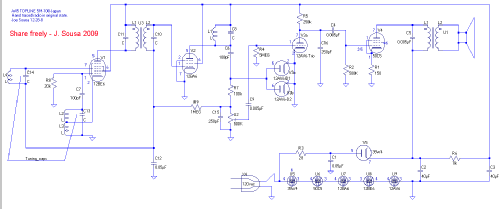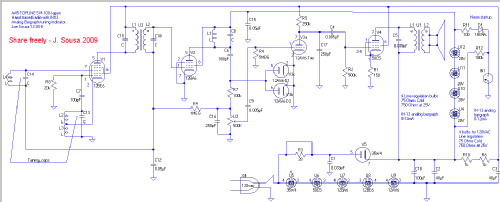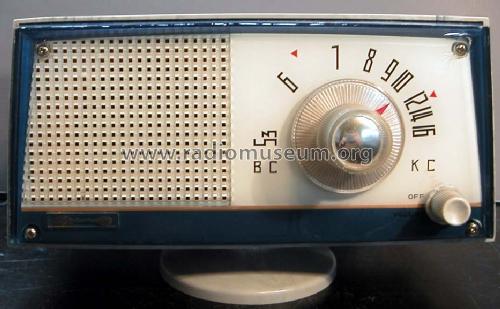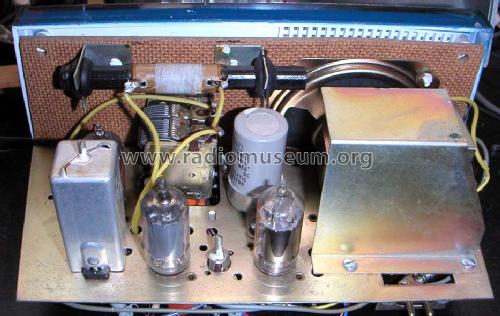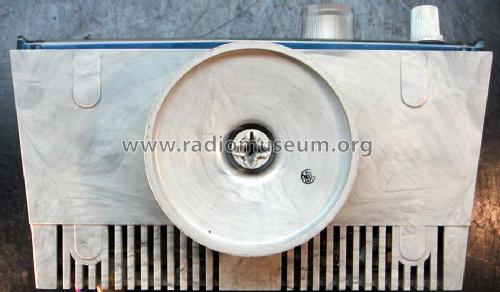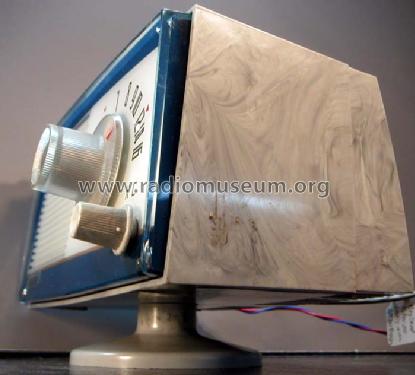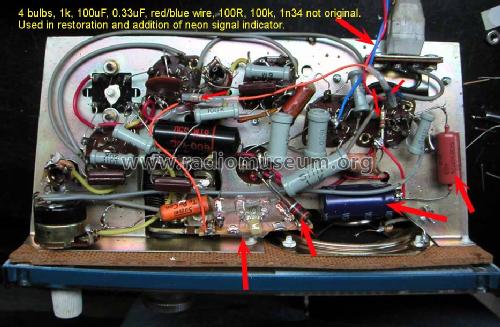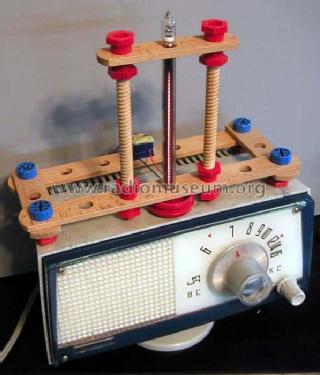Topline 5M-100
Topline; (where?)
- Country
- Japan
- Manufacturer / Brand
- Topline; (where?)
- Year
- 1962 ?

- Category
- Broadcast Receiver - or past WW2 Tuner
- Radiomuseum.org ID
- 147077
Click on the schematic thumbnail to request the schematic as a free document.
- Number of Tubes
- 5
- Main principle
- Superheterodyne (common); ZF/IF 455 kHz; 2 AF stage(s)
- Tuned circuits
- 5 AM circuit(s)
- Wave bands
- Broadcast only (MW).
- Power type and voltage
- AC/DC-set / 100-117 Volt
- Loudspeaker
- Permanent Magnet Dynamic (PDyn) Loudspeaker (moving coil) / Ø 3 inch = 7.6 cm
- Power out
- 1.9 W (unknown quality)
- Material
- Plastics (no bakelite or catalin)
- from Radiomuseum.org
- Model: Topline 5M-100 - Topline; where?
- Shape
- Design Radio or Novelty / Gadget - fancy or unusual shape.
- Dimensions (WHD)
- 8.5 x 4.5 x 5 inch / 216 x 114 x 127 mm
- Notes
-
Hand wired chassis made in Japan when other radios had printed circuit board. Plastic pedestal. Speaker style with very shallow cone, and the same steel frame material found in contemporary transistor radios. Identical to Lafayette FS-233.
- Net weight (2.2 lb = 1 kg)
- 1 kg / 2 lb 3.2 oz (2.203 lb)
- Price in first year of sale
- 10.00 $
- Literature/Schematics (1)
- -- Schematic
- Author
- Model page created by Joe Sousa. See "Data change" for further contributors.
- Other Models
-
Here you find 6 models, 5 with images and 1 with schematics for wireless sets etc. In French: TSF for Télégraphie sans fil.
All listed radios etc. from Topline; (where?)
Collections
The model Topline is part of the collections of the following members.
Forum contributions about this model: Topline; where?: Topline 5M-100
Threads: 4 | Posts: 12
Fellow Radiophiles,
I found this unusual conversion of an AA5 (All American 5) tube radio into a Theremin musical instrument in the pages of Popular Electronics August 1962. AA5 AC-DC radios with 5 series heater string tubes were often the base for many home-brew projects.
Enjoy,
-Joe
Joe Sousa, 13.Mar.10
I have measurement results for Detection and AGC performance in a late production Japanese AA5 radio model SM100 by Topline.
The measurements cover the original circuit and several circuit experiments, and can be found at AGC-detector-Measurements and the annotated schematic diagrams can be found at AGC-detector-schematics
The tube lineup is the classic 12BE6 pentagrid converter, 12BA6 IF pentode, 12AV6 dual detector diode and audio preamp triode, the 50C5 beam tetrode and the 35W4 power rectifier. The only noteworthy variation from the cannonical design, is that the 12BA6 IF pentode was loaded with a single tank circuit, rather than the usual 1:1 455kHz loosely coupled transformer.
I included measurements for AGC behaviour, detector performance, and stage gain for the original radio and several variants with improved detector gain and AGC compression.
In one of the circuit variations, I got the detector gain boosted to over 5, and AGC delay improved compression for signals in my urban home area.
The original AGC action compressed 40dB at the input into a 10.7dB range at the detector output. I added a 3V AGC delay and reduced the output further, to a 6.9dB range. The greatest benefit of the AGC delay was a combination of increased gain for weak signals and a more effective moderation of the strongest signals. The largest gain increase was 12dB.
Detector measurements and improvements with positive feedback:
The detector improvement came as the result of a musing about what whould happen if audio feedback from the voice coil were applied to the cathode of the 12AV6 dual diode & triode.
See pages 5,6,7,9 of AGC-detector-schematics
The common cathode shared by the triode and diodes meant that detection would be affected. As it turns out, Negative voltage feedback to the triode cathode works as Positive feedback for the 12AV6 detector diodes sharing the same cathode. This positive feedback is very helpful to sharpen the soft forward characteristic of vaccum tube diodes.
The sharpening of the diode characteristic happens because the audio at the cathode works as a variable diode bias that follows the audio envelope. The total voltage drive presented to the diodes is increased, as a result: IF voltage drives the detector anode and audio drives the detector cathode in opposing directions.
The amount of Positive feedback applied to the detecting diodes is set by the volume control between the detector diodes and the 12AV6 triode grid.
At full volume, which may be needed for the weakest signals, the positive feedback more than doubled detector output. This was observed in the attached measurements, and also resulted in much better audio fidelity for low level audio signals.
As was the original goal, the negative feedback for the triode section also improved audio tone at any volume level. The amount of negative feedback for the triode is fixed because it does not go through the volume control.
Peak-to-Peak detection:
While pursuing possible improvements for AGC action, I thought to double detected audio and AGC voltage output by replacing the 100k filter series resistor at the detector output, with a 1N34A diode. This transformed AGC detection from peak envelope detection to peak-to-peak envelope detection, thus doubling detected output for all IF signals driving the detector above about 50mV.
See page 3 of AGC-detector-schematics for the first implementation of p-p detection with the 1N34A.
As expected, very low level signals are more difficult to detect with the two diode drops from the original thermionic diode in series with the 1N34A, than with just one diode drop. But once audio feedback was applied as described above, the low level limitation was eliminated.
Guyla Kiss in Holand has used p-p detection in some of his AM tube radio designs.
The combination of voltage doubling from p-p detection, and Positive feedback to the thermionic diode cathode resulted in a 5-fold increase in detected audio output. Listening tests confirmed improved low level signal fidelity.
See page 5 of AGC-detector-schematics with p-p detection for AGC and Audio.
The intended improvement from p-p detection in signal compression was negligible.
The 5 fold increase in p-p detected output with PFB is useful to make up for the gain loss from audio feedback around the audio amp.
Full Gm/gain from output Pentode:
While tinkering with the radio, I also tried to increase forward audio gain, while reducing component count. I did this by taking the required negative bias for the 50C5 beam tetrode from the local oscillator section of the 12BE6 pentagrid converter.
See page 4 of AGC-detector-schematics
This particular oscillator variant used a Hartley circuit with a coil tap for the cathode and thightly coupled top of the tank to the grid. This thight coupling that does not rely on a low capacity coupling to the grid for oscillation, as a result, it yields a very flat grid leak self bias voltage around -12V over the entire tuning range. Oscillators with very light capacitive feedback to the grid tend to have more oscillation amplitude variation over the tuning range. The negative self bias is approximatelly half of the p-p oscillation amplitude at the grid.
I saw about 1V of variation in self bias over the tuning range. This negative bias trick could have been used since the dawn of the local oscillator in superhet sets, but I have never seen it applied anywhere.
The increase in gain comes from the hard grounded cathode of the 50C5. Shorting out the 150Ohm unbypassed cathode resistor adds about 6dB with the full realization of the available 7.5mS transconductance of the 50C5.
In a private communication with Ed Lyon (Radio Age editor), he recalled seeing this kind of bias as a cost saving measure in some Japanese radios that were contemporary with the Topline SM100 radio that is the subject of these experiments. Ed warned of the potential for overheating in the radio, should the local oscillator stop running. I made extra measurements for current and power draw with the 50C5 driven with 7.5V bias and with 0V bias. See the schematics on pages 8 and 9 at AGC-detector-Measurements. These schematics show measured currents and power dissipation as a result of loosing bias on the 50C5. In this particular radio, the added dissipation of the 50C5 at zero bias did not cause dangerous rise in internal temperature.
This method of pentode bias from the LO would have been preferable to the method that was common when electrolytic capacitors were expensive and Power tetrode gain was not very high. This other method employed a resistor in the B- path to create a negative voltage. Often this voltage had a lot of hum.
Another place where this method of bias would have been very convenient is with battery radios, because the power tetrode had a grounded directly heated filament. These radios used the resistor in the B- leg, and it had to be bypassed by an electrolytic cap.
But, keep in mind that using the LO as a source of bias requires that the oscillator amplitude, and thus the DC bias it generates to be fairly constant over the tuning range.
AGC delay:
AGC delay is a misleading term that means the elimination of AGC voltage for any signals below a certain level. With AGC suppressed for the weakest signals, the radio runs at full gain when it is most needed. A 3V delay means that only signals that exceed 3V in amplitude at the detector will start to reduce RF and IF gain.
Pages 6 and 7 of AGC-detector-schematics show the first experimental version of adding a 3V delay, and the final version, that employs a cathode resistor to obtain the 3V delay.
As I mentioned the introduction above, the 3V delay improved the original AGC compression from 60dB/21dB to 60dB/14.6dB. This improvement also includes the voltage doubling from p-p detection in the AGC voltage. The added 12dB gain for signals that previously only developed -1V of AGC voltage, and the more effective compression of the strongest signals made a noticeable difference in tuning the radio across the dial.
The last page of AGC-detector-Measurements shows the gain of each stage (12BE6 converter and 12BA6 IF) as a function of AGC voltage. Note that AGC is most effective in the -7V to -2V range. For larger signals, the gain drop is sacrificed to maintain low distortion. Also note that a grid bias below -1V causes a reduction in stage gain due to slight grid conduction that loads the high Q tank circuits at the grids.
The Philips796A from 1936:
After I finished my experiments, I came across a very similar detector design in the Philips 796A from 1936. This radio includes the AGC delay resistor at the cathode of the triode, as well as feedback from the voice coil to the same Triode cathode. This was a completely fortuitous, but fun coincidence. So this radio should have higher sensitivity, better AGC action and cleaner detection than other contemporary 5 tube superhet designs.
This Philips 796A includes a tuning eye indicator that is driven by the top of the volume control which has no AGC delay, this means that the tuning eye is active for signals below the AGC delay voltage.
One drawback of introducing AGC delay to my radio is that I lost signal indication for signals below the 3V AGC delay. The IN-13 monitors the current of the IF stage, so it is dependent on the delayed AGC signal.
A 10MByte video clip showing operation of the radio with the IN-13, but may be too large to post at RM, can be see on my personal page .
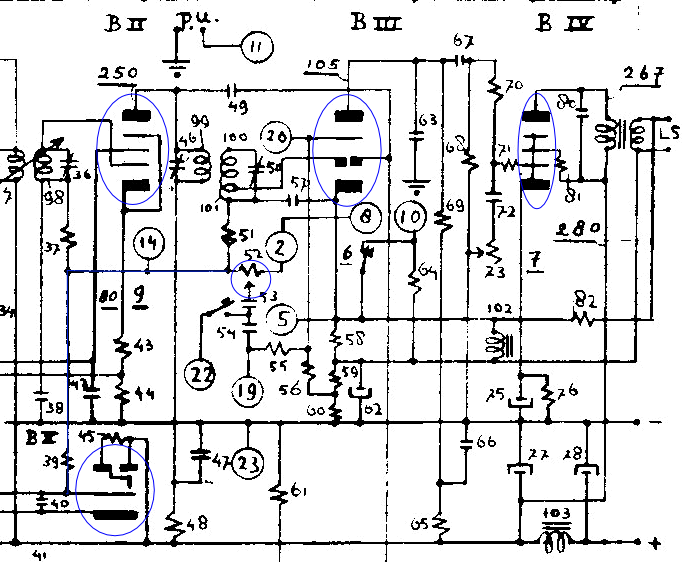
Comments invited,
-Joe
Joe Sousa, 08.Feb.09
I have added the Russian IN-13 analog bargraph neon indicator to a classic 5 tube AC/DC radio. The IN-13 indicates signal strength and makes tuning more precise.
The IN-13 is the modern version of neon tuning indicator tubes used in the 1930's, like the Tune-a-lite tube in a FADA radio with the RW chassis, or a similar tube in a Cossor radio.
But the IN-13 offers much better performance with a specified linearity of 2% and a much crisper plasma shape up to 10cm/4in long. The gas is neon, so the glow is orange, but a purple glow can be obtained from some IN-9 types.
You can see a photo and video clip of the completed IN-13 setup.
The schematic is also available at this link and in the RMORG archive for the 5M-100 Topline/Toptone radio.
The IN-13 plasma fires around 120V and drops 100V when it is on. The 100V drop is independent of current up to 5mA, when the plasma is at full 10cm length. Further current increase bightens the full lenght, and the internal drop rises rapidly above 100V.
The IN-13 senses the load current variation in the 12BA6 plate current that results from AGC action. A strong signal reduces plate current, and this current is fully absorbed by the IN-13. a very strong signal makes the bar go to full lenght. and even weak signals shows some increase in plasma lenght. Without a signal present, the plasma lenght is 1cm or less.
The IN-13 operating range is set by the new power resistors added in the B+ supply. I chose to use 28V 40mA bulbs for these resistors because they reduce the effect of mains voltage on bargraph plasma length. These four light bulbs in series, only drop around 30V, but they do a good job of rejecting 10V of line voltage variation.
I added a 1k resistor in series with the existing 1k resistor, to power the 12BE6 and 12AV6. Perhaps I should have connected the 12BE6 screen pin6 to the 100V drop that is regulated by the IN-13, and improve oscillator stability of the 12BE6. This is an afterthought.
The 1N34 diode and 100k resistor were added to insure startup from the higher B+ supply around 135V.
The schematic continues in the next figure to show the connection to the 12BA6 IF stage plate. Note that this radio came with a single tuned circuit at the IF output.
This shot shows the final wiring for the IN-13. The bulbs glow red and regulate current to the IN-13 and 12BA6 IF stage. The two extra caps reduce hum and interference. The red-blue wire drives the anode and cathode of the IN-13, respectively.
Comments invited,
-Joe
Joe Sousa, 08.Feb.09
The correct brand is Topline, not Toptone. Both are Japanese, and perhaps related.
Regards, -Joe Sousa
Joe Sousa, 07.Feb.09
